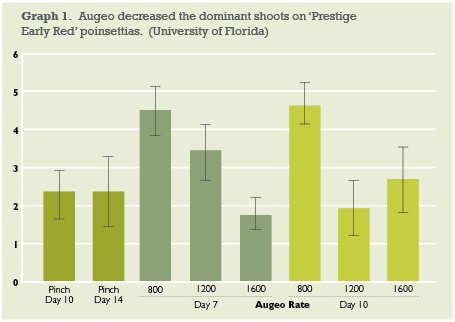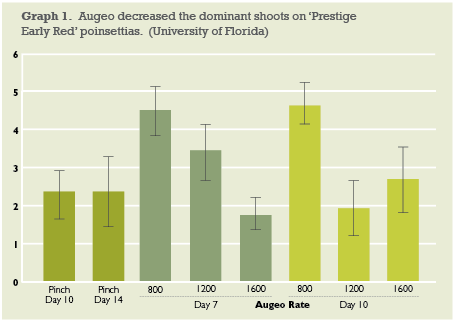
Refining Poinsettia Production
Each year the North American Poinsettia Trials evaluates hundreds of poinsettia cultivars, many of which are new to the market. However, as any poinsettia grower will tell you, selecting the right cultivar is only the beginning. Many decisions have to be made during the course of a poinsettia season to produce a high quality crop in a short amount of time and make a profit. Thus, growers often finesse and tweak the production schedule to save money. Each of the three trial research locations — University of Florida, Vineland Research Station and North Carolina State University — conduct a number of additional trials and experiments to help growers refine their poinsettia production.
These additional trials determine optimum PGR rates, select the best color combinations for multi-plant pots, refine insect and disease control, use callus cuttings to eliminate the need for misting, test growing media and so forth. In this article we will present results from our studies using Augeo to replace pinching and Fascination to shorten production time. We will also present results from biocontrol of silverleaf whitefly and on the use of various growing media.
Augeo
First of all, we have to say that using Augeo is not for the faint of heart. The plants will look seriously mistreated by three weeks after application, but the plants will grow out of the phytotoxicity with minimal signs of treatment by six weeks after application (Figures 1a and 1b). By this time the increase in branching will be evident.
University of Florida tested 800-, 1,200- and 1,600-ppm Augeo applied either seven or 10 days after planting on ‘Prestige Red’, ‘Jubilee’, and ‘Prestige Early’ and measured the height and the difference in height between the tallest shoot (usually the central shoot) and the next highest shoots (laterals) (Graph 1). For pinched plants and those where Augeo worked well, the tallest shoot was also a lateral shoot. Pinched plants without Augeo were included. In another experiment ‘Tikal’ and ‘Prima’ were tested. ‘Prestige Early Red’ showed excellent branching with plants treated with 1,200- and 1,600-ppm Augeo. Results were also fairly good for Prestige, but were not as impressive on ‘Jubilee’.
North Carolina State University tested 800 or 1,600 ppm applied once 10 days after transplanting and 800 applied twice (second application seven days after the first) to ‘Jubilee’, ‘Noel’, ‘Prestige’, ‘Prima’, ‘Stargazer’ and ‘Titan’. Pinched plants without Augeo were included. Data collected included plant height, diameter, number of shoots and visible bract clusters, and days to first color, visible bud and anthesis. The tallest plants were generally those treated with only 800 ppm once, showing the lack of control of the main stem.
However, plants treated with 1,600 or 800 ppm twice were generally the same height as the pinched plants. Treating with 1,600 ppm once or 800 twice delayed first color, visible bud and anthesis the most on ‘Noel’, by up to eight days, and to a lesser extent on the other cultivars. Most striking was the increase in shoot number due to Augeo, but interestingly most of those shoots did not contribute to the number of bract clusters evident at the end of the experiment (Graph 2). Most of the shoots remained below the canopy and increased the number of visible bract clusters of only one or two for most cultivars.
Augeo Summary
• Augeo is effective on poinsettias to promote lateral branching on non-pinched plants and on some cultivars produced a plant visually identical to pinched plants.
• The best rate varied with the cultivar from 800 to 1,600 ppm when applied once. One application of 1,600 ppm generally worked as well as two applications of 800 ppm. When rates are too low, the main shoot will remain dominant and branching will be poor. PGR sprays two to five weeks after the Augeo spray can help were this occurs.
• Best application time seems to be about a week earlier than a normal pinch.
• Separate Augeo trials have shown that uniform spray volumes are need for consistency of response and that Augeo can be washed off plants with overhead irrigation within 24 hours of the spray.
• While Augeo-treated plants will usually have many more laterals than a pinched plant, most of the lateral shoots will remain below the canopy and Augeo-treated plants will have only one to two more bract clusters at finish, compared to a pinched plant.
• Augeo treatments often did not reduce final plant height and PGRs for height control will be needed.
• First color, visible bud and anthesis may be delayed, with the greatest delay observed so far being one week at anthesis for ‘Noel’.
Fascination
When properly used, Fascination is a great tool to increase plant height and bract size, especially from the over application of PGRs. However, there are a number of potential side effects, which UF and NCSU examined in their experiments.
NCSU treated ‘Jubilee’, ‘Mars Red ‘09’, Premium and Prestige plants with 5-ppm Fascination sprays (+5 ppm Capsil) applied one week after pinch, two weeks after pinch, at first color and two weeks after first color. Fascination drenches (2 ppm) were applied two weeks after pinch, at first color and two weeks after first color) or water (control). One half of the plants were transferred to a postharvest evaluation room approximately two weeks prior to anthesis date. Data collected included plant height at 30 days, 60 days and finish, diameter, and days to first color, visible bud and anthesis.
Sprays produced taller plants than drenches for three of the cultivars, but drenches produced taller plants for ‘Premium Red’. Fascination applications also delayed flowering with more delay from sprays than more drenches. The increase in height was directly related to the delay in flowering: for every inch increase in height, flowering was delayed about five to six days for ‘Jubilee’, two days for ‘Mars Red ‘09’, five days for sprays and less than a day for drenches of Premium, and about three to five days for sprays and less than a day for drenches on ‘Prestige Red’.
University of Florida sprayed Fascination at 5 ppm on ‘Prestige Early Red’ on Nov. 8 when plants were seven to 10 days prior to anthesis. One Bonzi drench or spray was applied one or two weeks before Fascination, at the time of the Fascination spray, or one week after Fascination. One week after the Fascination spray was applied plants were sleeved for three days and then moved to a postharvest area. Plants not sprayed with Fascination and/or Bonzi were also included. The number of cyathia retained was recorded 12 days after shipping.
Plants treated with only Fascination dropped cyathia during postharvest. Bonzi seemed to moderate the negative effects of Fascination, with the best results from sprays. The best Bonzi treatments were applied at or before the Fascination spray and applications the day before shipping were not effective in reducing cyathia drop.
Fascination Summary
• Fascination can be used early in the crop schedule to increase height, but for most cultivars any increase in height will also delay flowering.
• Drenches are generally less effective than sprays, but also result in less flowering delay.
• Bonzi can be used to reduce the postharvest cyathia drop that can accompany the late schedule use of Fascination.
Biocontrol of Silver Leaf Whitefly
Since 2005, an increasing number Ontario poinsettia growers have been successfully using biocontrol to control SLWF developed in co-operation with Vineland colleague Graeme Murphy, Greenhouse IPM floriculture specialist. The adoption of biocontrol has occurred because Canadian growers have access to fewer insecticides for whitefly control.
Beginning 10 years ago, Vineland Station successfully superimposed a biocontrol program on the annual Cultivar Evaluation Trial to demonstrate its potential to local growers. In the past, unrooted cuttings arrived in Ontario with essentially no detectable SLWF. This year was different, with 10 to 15 percent of the cuttings of many cultivars detected with SLWF. 2012 was the year to really test whether bio-control would provide successful control in a semi-commercial environment (total of 2.500 15 cm poinsettia) given the already significant SLWF population present on the rooted cuttings at planting. Ultimately, the economics is the critical factor. Our biocontrol program for 2012 is summarized in Table 1.
Eretmocerous mundus is a parasitic wasp very specific to SLWF parasitizing second and third larval stage. It thrives well under high greenhouse temperatures. Amblyseius swirski is an aggressive predatory mite with a great appetite for both whitefly and thrips. Encarsia is another parasitic wasp best known for controlling GWF but will also parasitize SLWF.
Biocontrol Summary
• The high SLWF population present at planting was successfully controlled throughout the cropping cycle without the use of pesticides to below the threshold where whitefly can begin to be detected. Many growers using conventional pesticides had similar populations at shipping.
• The cost of the biocontrol program at $0.53 per pot is very high, but could be considered cheap if traditional pesticides fail. Reducing the cost while achieving similar control will be the challenge.
• Next year eliminating the final two bi-weekly introductions of ‘mundus, and Encarsia’ will be studied when greenhouse temperatures are being lowered. It is critical to front load the introductions early in the season before the SLWF population explodes during naturally high greenhouse temperatures when the life cycle is short.
• Next year the impact of reducing Swirski introductions to the first two bi-weekly introductions will be studied, because the breeding sachets provide four weeks of emerging adults.
Growing Media
Growers frequently ask for an unbiased opinion on any number of new soilless media blends developed by commercial growing media companies. Unfortunately, growing media trials carried out by growers are often not successful, because insufficient plants are planted in the trial media so that those plants can be managed on a separate irrigation valve or flood floor. This past fall we compared the new Agro-Mix G10 media developed by Fafard with the Sunshine #4 from Sungro Horticulture. The key difference between the two media is that Agro-Mix G10 contains 100 percent extra coarse peat, while Sunshine #4 is a blend of peat and coarse perlite.
Thirty poinsettia cultivars from the Poinsettia Cultivar Evaluation trial were planted in 15 cm pots, grown in a recirculating sub-irrigation trough system with each trough having its own small holding tank. This allowed plants in the two media to be irrigated as required. Frequency of irrigation and number of PGR applications were recorded. Plant height and inflorescence diameter were measured at plant maturity.
Growing Media Summary
• Plants grown in the Fafard Agro-Mix G10 were consistently 1.6 to 2 inches shorter than those grown in Sunshine #4 confirming Agro-Mix G10 has lower water retention and less available water for plant growth (Figure 3a).
• The diameter of the bracts was not consistent and showed less size differences, because bract expansion occurred under cooler and lower light conditions.
• Plants grown in Fafard Agro-Mix G10 received two fewer Cycocel applications and were still shorter, because of lower available moisture for plant uptake.
• Plants grown in the Fafard media were irrigated 30 percent more times than those grown in Sunshine #4.
• Root systems were healthy in both media, but the roots in Fafard media were generally much coarser (Figure 3b).
Find out how cultivars responded to the use of plant growth regulators, biocontrols and media.



 Video Library
Video Library 




















